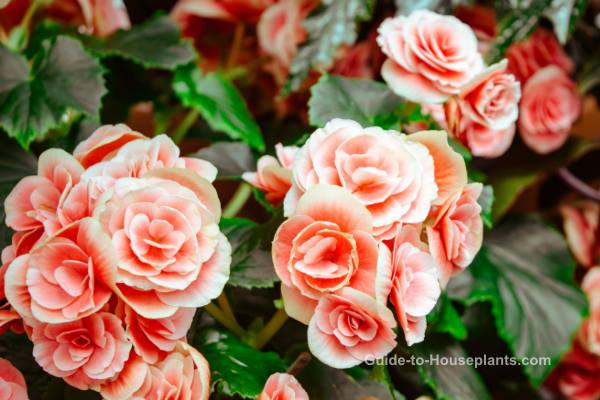
When you meet begonia care wants, you possibly can count on months of spectacular flowers. Happily, it is fairly straightforward.
Right here you may uncover how you can develop Reiger begonia and different tuberous hybrids as houseplants. Discover out what these beauties have to thrive year-round, plus how you can get essentially the most flowers and make it rebloom.
Get to Know Your Begonias
The begonia household consists of greater than 1,000 species and 10,000 hybrids and cultivars. Ongoing breeding improves these stunning flowering home crops, giving the brand new hybrids extra blooms than ever earlier than.
Supreme for rising indoors, these xheimalis are hybrids of Begonia socotrana (found on the island of Socotra, off the coast of East Africa) and tuberous hybrids (with origins from South America). Typically known as winter-blooming begonia, ongoing breeding presents attractive new varieties which can be accessible in bloom any time of 12 months.
Begonias are full, bushy, and low-growing. Their thick, reddish stems develop from tuberous roots beneath the soil. How large do they get? These hybrid begonias sometimes attain a top of 12-18 in (30-45 cm).
Massive, delicate, dark-green leaves create a wonderful backdrop for considerable clusters of pleasant flowers which can be accessible in orange, white, yellow, crimson, and pink.
When shopping for a brand new plant, it is best to decide on one which has good bud coloration and has simply began to bloom. You may typically discover these crops labeled as Elatior or Reiger hybrids, however they embody many sorts.
Tuberous begonias will go dormant after flowering, however you possibly can convey them again into bloom, if you would like. See “After-blooming begonia care” under to learn the way.
Rising Begonias 12 months-Spherical
Preserve the soil moist. Permitting it to dry out will depart the plant inclined to illness. However you do not need soggy soil, both. Overwatering your begonia will trigger leaves to wilt and switch yellow. Lower off any affected leaves as quickly as you discover them. They’re more likely to rot and entice botrytis fungus.
Lower off spent flowers. Prune off lifeless flowers to maintain your plant trying neat and to encourage extra blooms.
Test foliage for fungus. Begonias are susceptible to powdery mildew — a powdery white fungus that develops on its leaves. Spray an affected plant with a fungicide and maintain it away from different crops to stop it from spreading. Are leaves badly affected by mildew? Lower them off; it is higher to lose leaves than to take an opportunity on the fungus spreading.
Look ahead to bugs. Happily, crops grown indoors aren’t typically bothered by pests. Nonetheless, there are just a few to look at for. Thrips might assault, inflicting distorted trying flowers and leaves. Lower off any affected elements of the plant. Spider mites are tiny, however you may possible discover their tremendous webs. Maybe essentially the most dreaded of houseplant pests, mites could cause lots of harm. Isolate any infested houseplant and deal with it straight away. In case your plant is badly infested, do away with it. Mealybugs seem like white cotton-like specks; take away them with a cotton swab dipped in alcohol. Don’t use oil-based pesticides on begonias to regulate pests, which is able to harm their delicate foliage and flowers.
For extra assistance on begonia pests and illnesses, examine this web page from The American Begonia Society. You may discover photos, ideas and solutions for stopping and treating issues.
After-Blooming Begonia Care
Begonias are difficult to take care of and regrow the next season, so they’re typically handled as non permanent home crops. Nonetheless, it is totally attainable to convey them again into bloom the next 12 months.
- After flowering, in the reduction of on watering in order that the plant is barely moist, however not utterly dry.
- Preserve it away from mild throughout this dormant interval. In about 6-8 weeks, the foliage will die again.
- Lower off all of the foliage, leaving 3 in (7.5 cm) stems.
- When new development seems, take away the stems from the mother or father plant and pot them in new potting combine. You possibly can discard the mother or father plant.

Indoor Begonia Care Suggestions
Gentle: Give your begonia loads of vibrant mild whereas it is blooming, however maintain it out of direct daylight which might scorch its leaves.
Water: Preserve soil evenly moist, not soggy. Enable high inch of soil to dry between waterings.
Humidity: If relative humidity drops under 40%, use a cool-mist room humidifier or maintain pot on a tray of moist pebbles to extend humidity. Do not mist begonias as a result of their delicate leaves are susceptible to mildew.
Temperature: Common room temperatures (65-75°F/18-24°C) are very best. Do not expose begonias to temps under 55°F/13°C, as a result of they’re simply broken.
Soil: Peat-based soilless combine comparable to African violet potting combine works properly. Use a pot with drainage holes to stop soggy potting medium.
Fertilizer: Begonias like a gradual food plan of fertilizer whereas they’re rising and blooming. Feed crops each 3 weeks with a high-phosphorus liquid fertilizer diluted by half.
Propagation: Take 3-4 in (7-10 cm) stem tip cuttings at first of the rising season and root in contemporary potting combine.